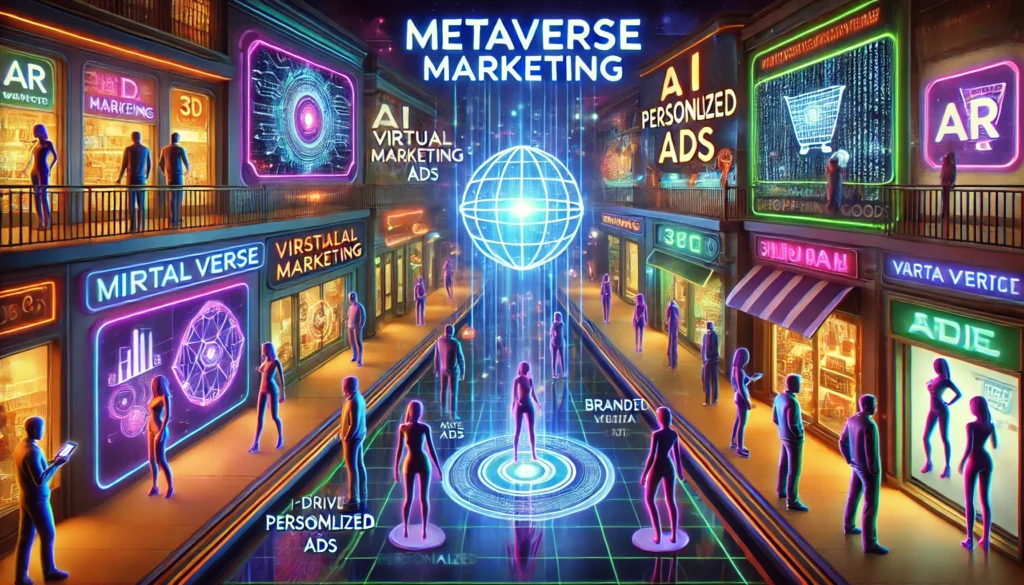
Introduction to the Metaverse

What is the Metaverse?
The Metaverse refers to a collective virtual shared space created by the convergence of virtually enhanced physical reality and persistent virtual worlds. Think of it as an interconnected network of immersive digital experiences where people can socialize, work, shop, and explore using avatars. It’s powered by technologies like augmented reality (AR), virtual reality (VR), and blockchain.
For marketers, the Metaverse represents an exciting new frontier—offering endless possibilities for brand engagement, storytelling, and customer interaction.
Why Marketers Should Care
Early adopters of Metaverse marketing can build brand loyalty, attract younger audiences, and create unforgettable experiences in ways traditional marketing cannot achieve. As the Metaverse grows, businesses that adapt quickly can seize the first-mover advantage and dominate this untapped virtual space.
Why the Metaverse is a Game-Changer for Marketing
The Metaverse shifts traditional marketing into a multi-dimensional experience. Brands are no longer limited to static advertisements or e-commerce platforms; instead, they can offer interactive and participatory experiences to their audiences.
Key reasons why marketers should care:
- Increased Engagement: Users spend more time in immersive environments, creating opportunities for stronger connections.
- Direct Customer Interaction: Through avatars, brands can engage with consumers in real time.
- Endless Creativity: The Metaverse allows brands to build custom virtual worlds that reflect their values and vision.
Key Features of the Metaverse that Benefit Marketers

- Virtual Reality (VR): Enables users to experience products and services virtually.
- Augmented Reality (AR): Offers interactive overlays for real-world products and environments.
- Interoperability: Platforms are interconnected, allowing seamless customer journeys.
- Decentralization: Blockchain ensures transparency and security in transactions and ownership.
- Persistent Environments: Virtual spaces remain active, even when users are offline, offering 24/7 engagement.
Opportunities for Early Adopters in the Metaverse
Early adopters can gain a competitive edge by leveraging the following opportunities:
- Exclusive Brand Presence: Establishing a virtual space before competitors enter.
- Creating Unique Digital Assets: Selling branded NFTs, such as digital clothing or virtual collectibles.
- Innovative Advertising: Hosting virtual events, concerts, or workshops.
- Global Reach: The Metaverse transcends geographical boundaries, making it easier to connect with a worldwide audience.
How to Get Started with Metaverse Marketing
- Define Your Goals: Identify what you want to achieve (e.g., brand awareness, sales, or engagement).
- Select the Right Platforms: Choose virtual environments that align with your audience, such as Decentraland, Roblox, or Fortnite.
- Invest in AR/VR Technology: Ensure your brand offers immersive experiences.
- Collaborate with Experts: Work with Metaverse developers and designers to create high-quality virtual content.
- Start Small: Launch pilot projects to test the waters and gather feedback.
Building Immersive Customer Experiences
To captivate your audience, focus on creating memorable experiences such as:
- Virtual Shopping Stores: Let customers browse and try products virtually.
- Gamified Interactions: Use game elements to make campaigns more engaging.
- Custom Avatars and Spaces: Design virtual avatars and branded environments that reflect your brand.
Role of Blockchain and NFTs in Metaverse Marketing

Blockchain technology powers the Metaverse by ensuring secure ownership and transactions.
- NFTs (Non-Fungible Tokens): Allow brands to create unique digital assets that customers can own, trade, or showcase.
- Smart Contracts: Simplify virtual sales and licensing agreements.
- Tokenized Experiences: Offer exclusive access to events or products through digital tokens.
Case Studies of Successful Brands in the Metaverse
Nike:
- Launched Nikeland in Roblox, combining gaming with branded experiences.
Coca-Cola:
- Sold NFTs featuring exclusive digital art and hosted immersive events.
Gucci:
- Created a virtual garden, allowing users to explore and purchase branded digital items.
Balenciaga:
- Partnered with Fortnite to sell virtual fashion items to millions of gamers.
Challenges and Risks for Early Adopters
While the Metaverse offers immense opportunities, it comes with challenges:
- High Costs: Developing virtual content and platforms can be expensive.
- Uncertainty: The Metaverse is still evolving, making it hard to predict long-term trends.
- Technical Complexity: Requires specialized knowledge in AR, VR, and blockchain.
- Regulatory Issues: Intellectual property and data privacy laws in the Metaverse remain unclear.
Future Trends in Metaverse Marketing

- Enhanced Interoperability: Platforms will become more interconnected.
- AI Integration: Artificial intelligence will improve personalization in virtual spaces.
- Virtual Influencers: Digital avatars will become the new brand ambassadors.
- Decentralized Commerce: Blockchain will enable direct peer-to-peer transactions.
- Mixed Reality Experiences: Combining physical and virtual worlds for seamless customer interactions.
FAQs About Marketing in the Metaverse
Q1: What is the cost of marketing in the Metaverse?
A: It depends on the campaign complexity, ranging from $10,000 to over $1 million for large-scale virtual projects.
Q2: Which platforms are best for Metaverse marketing?
A: Platforms like Roblox, Decentraland, Sandbox, and Fortnite are currently leading in Metaverse marketing.
Q3: Is Metaverse marketing suitable for small businesses?
A: Yes, small businesses can start with cost-effective solutions like AR filters or NFTs.
Q4: How can I measure success in Metaverse campaigns?
A: Use metrics such as user engagement, virtual attendance, and NFT sales to evaluate performance.
Q5: What industries benefit the most from Metaverse marketing?
A: Fashion, gaming, real estate, and retail are thriving in the Metaverse.
Conclusion
The Metaverse is reshaping the future of marketing by merging creativity, technology, and interactivity. For early adopters, it offers unparalleled opportunities to engage audiences in ways traditional platforms cannot. By building immersive experiences, leveraging blockchain, and embracing new technologies, brands can lead the way into this exciting digital frontier.




2 thoughts on “Marketing in the Metaverse: Opportunities for Early Adopters in 2024”